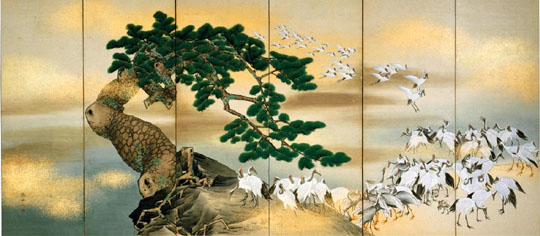The Hara Museum ARC in Shibukawa, Gunma Prefecture, has just opened a revolutionary new space designed by world-renowned architect Arata Isozaki that interweaves motifs of Japanese traditional architecture and art with modern ones. Called the Kankai Pavilion, the exciting new exhibition space is being launched with "Beyond Time, Beyond Space," an exhibit running till Sept. 23.
The Kankai Pavilion was built to commemorate the 20th anniversary of the founding of the Hara Museum ARC, the annex to the Hara Museum of Contemporary Art in Shinagawa Ward, Tokyo. The pavilion houses a rare collection of traditional Japanese and Chinese art acquired by Rokuro Hara, great-grandfather of the museum's current director, Toshio Hara. The collection includes fusuma (sliding door) panels decorated by Kano Eitoku (1543-1590) and other members of the prestigious Kano School. Dating back to the Momoyama Period (1573-1615), the panels are from the Nikko-in guest hall at Miidera Temple in Shiga Prefecture.
Extremely compact at 117 sq. meters, the Kankai pavilion is reminiscent of traditional Japanese tea rooms. The visual compression that takes place within the pavilion results in a perception of expansiveness that belies the actual room dimensions. Entering the pavilion, visitors will be struck by the interplay of light and volume within the space, which is subdivided between an outer perimeter and an inner area that is 18 tatami mats in size (30 sq. meters), the dimensions of a shoin room of the Momoyama Period.



















With your current subscription plan you can comment on stories. However, before writing your first comment, please create a display name in the Profile section of your subscriber account page.